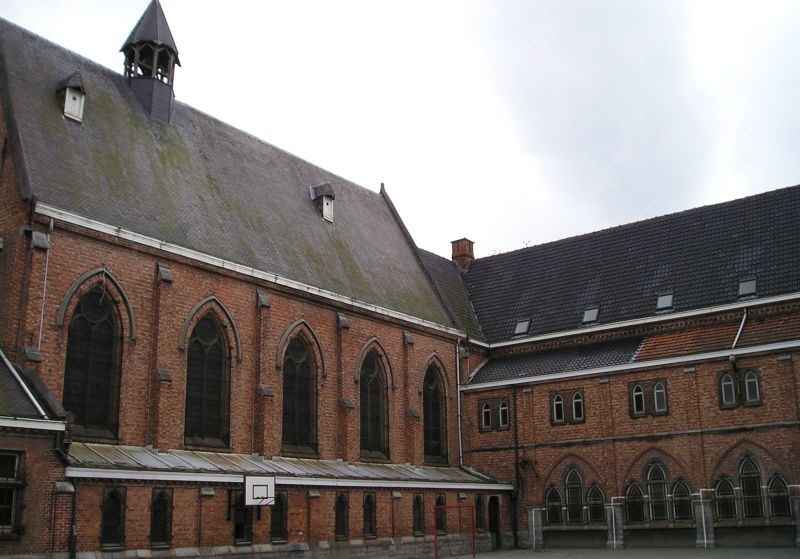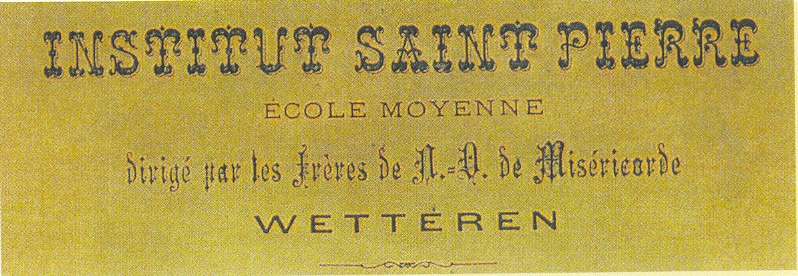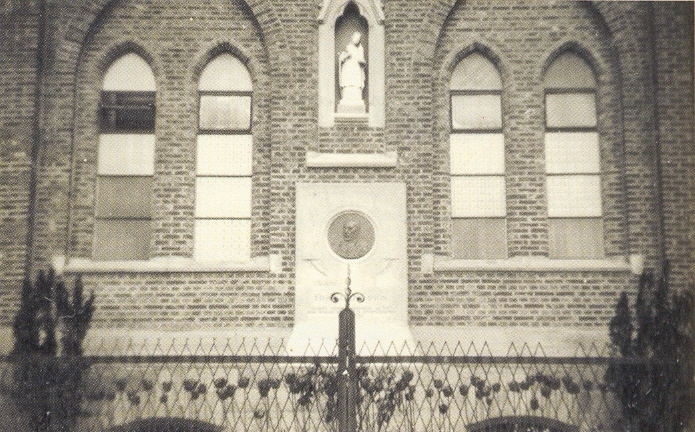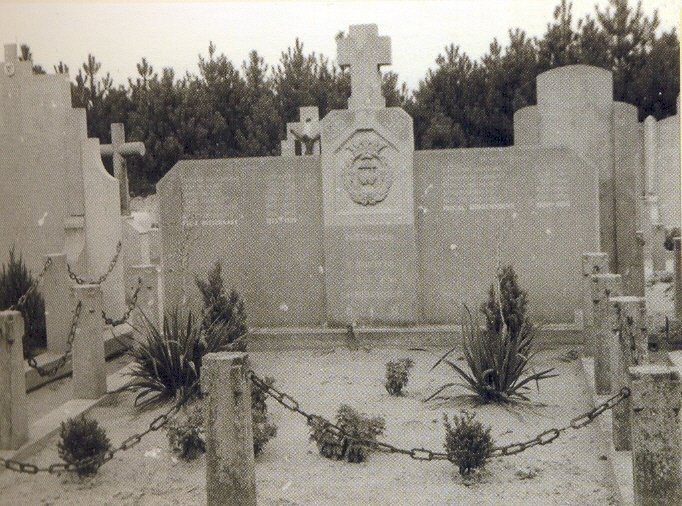The community of Wetteren, which was connected with the Scheppers Intsitute or the former Saint-Barbara, has no longer a Brother.
The start of the 21st century
In 1999 Brother Louis De Wijngaert, also known as Brother Sebastiaan, died in Wetteren. He accomplished different tasks in the school and in the community. He was especially known as the choir leader of as well the school choir, as the Parish choirs. He was the previous last Brother in the community.
The First three Brothers for the orphanage

March 20th, 1879; the first three Brothers came to the quarter “Beirstoppel” that was situated on the left bank of the Schelde in Wetteren. Those were the Brothers Emmanuel De Cort (the first manager), Brother Alfons Platner and Brother Frederik Goethals, who would be responsible for the kitchen until his death in 1902. The chapel and the chaplains residence were finished, but the buildings in which the class rooms had to come, were not finished completely.
The gunpowder factory immediately lend the old offices. The ground floor was used as class rooms and the first floor as a convent. They started with three classes of each two years of study.
July 2nd,1879, the chapel was solemnly consecrated by the Dean of Wetteren, The Reverend Sir De Beuckel. Soon, Reverend Sir Walrave became the first chaplain. In the beginning he stayed with his parents in Laarne and daily he celebrated mass.
The first manager and the finishing of the chapel

Alfons Hooghewijs, the well known Brother Prosper, was the first orphan that was enrolled in the “Institution”, on July 8th 1879. The first manager was Brother Simon De Roy, teacher and very capable gardener, son of a well known gardeners family from “Sint-Katelijne-Waver”. A bronze picture of Brother Simon still hangs on the façade besides the entrance of the chapel at the Cooppal avenue.
May 24th 1887, the large glass window was installed above the choir in the chapel; it represented the litany of Our Holy Mary. That same day Brother Florent Labarre and Brother Gregoor Vinck came to Wetteren; this last one replaces Brother Emmanuel as manager of the Institution. A few months later the highest part of the chapel was also put in use.
In 1904, at the occasion of 25 years existence of the school, the firm Cooppal, donated four new glass windows to the chapel. One year later, Brother Simon would still place two other glass windows and this at the expense of the Congregation.
The towerless chapel
In January 1986 a heavy gust of wind pulled the little tower from the chapel in the Scheppers Institution. The tower pierced in the ground where you can see the present traffic lights nowadays at the entrance of the primary school. It was evening and happily there were no entering boarders or accidental passengers in the neigbourhood.
Rebuilding the tower in its original form would cost about 10 million old Belgian Francs. Therefore they chose for a small tower. A working party is zealous for the classification of the chapel and hopes to restore it one day.
Two communities in Wetteren
Because of the constant growth of the number of orphans in the Institution and of the pupils in the primary school, the horticultural school and the professional school, more and more Brothers came to Wetteren to take care of the education and of the raising of the youth.

At the start of the school year 1902-1903, Brother Simon, became as well manager of the horticultural school as general Manager. Brother Rombaut left saint-Barbara to found a separate community together with the Brothers Valentijn, Benedictus, Ladislaus and Elzear and this at the secondary school Saint-Peter in the center of Wetteren.
Scholasticism
From 1951 till 1963 the scholastic education of the Brothers of Scheppers was established in the community of Wetteren. About twenty temporarily professed received a professional education here besides a deepening of their novitiate formation.
A few Barundi also remained in the scholastic education in Wetteren. In 1973, their native country was the scene of the wildest murders during the tribes quarrels. Together with decades of their pupils, the old scholastics Brother Joseph and Brother Bernard Ngendabanyikwa were murdered.
Condemned as spies
October 1915: the Brothers went through the blackest and saddest days of the war. By an irresponsible imprudence of a farmer servant who had hidden three carrier-pigeons on an attic, the Manager Brother Simon De Roy and Brother Rodolf Embrechts ( superintendent on the farm), were condemned as spies by a German warrior tribunal and they were sent to a penal settlement in Düsselorf.
The verdict was: Brother Simon 2 years and 4 months, Brother Rudolf 2 years and 6 months, the farmer servant: 2 years and the municipality of Wetteren 2000 Mark penalty. Brother Claudius Bosschaert became acting manager of Saint-Barbara. Later Brother René Michielsen was nominated as manager.
Brother Rodolf, young and strong, survived his imprisonment. From Brother Simon they received a last letter in 1917 in which the diseased manager, exhausted by malnutrition and by the tough working circumstances, wrote to his co-Brothers: I don’t have to work anymore; one of these days I may rest forever. The censorship hadn’t understood; his friends had; Brother Simon was dying. He was transferred to a lazaretto in Lüttringshausen where he died July 5th, 1917.
A monument for and the transfer of Brother Simon De Roy

On Sunday August 6th, 1922, a monument was unveiled at the front of the Institution, besides the chapel, and this in remembrance of Brother Simon De Roy. In the presence of lots of clerical and secular authorities- amongst them the Chaplain Vandenherreweghen, the old Chaplain Walrave, the dean of Wetteren, the Canon Noterman, the families Libbrecht and De Roy, most of the Friars and lots of old- pupils- the monument was solemnly consecrated.
The plaque was made by Jan de Bo of Gent, and designed by Michel Van Huffel, an old- pupil. The text and the music of the ceremonial cantata Beati Misericordes were made by the brothers Octaaf and George Mortier, two orphans and old-pupils.
From the illustrated commemorative album we give the following passage: Brother Simon, once the time will wipe out your name, chiseled in this stone. The image of your paternal being, is although ineffaceable. Look after us and after your beloved Saint-Barbara Institution.
On January 16th, 1927, the mortal remains of Brother Simon De Roy were transferred to Wetteren. Till then, he had been buried on the churchyard of Lennep in Germany under the grave number Z.D. 320. With lots of splendour and marks of honour, Brother Simon was interred on the churchyard of Wetteren.
Buried Brothers in Wetteren

In Wetteren 22 Brothers are buried: the first one in 1897 and the last one in 2014. During the First World War the bridge over the Schelde had been destroyed. This particular fact was the cause that Brother Massart , who had fled from Scheppers-Mechelen and died in Saint-Barbara on November 28th 1914, was buried on the churchyard of Wetteren-ten-Ede.
In 1986 Brother Amedée Drieghe died in his birth-village Wetteren during his holiday. He is an old-pupil from Scheppers Institution and was General Superior of the Congregation.
The decease of a few pioneers
September, 26th 1950, Brother Rombaut Obbens passed away at the age of 81 years in Mechelen. He had spend all his youthful strengths at the horticultural school of Wetteren, after he had helped founding Saint-Peters-Institution and afterwards he had founded a horticultural school in Huberdeau (Canada).
With Brother Hilaire, one of the greatest figures that Saint-Barbara has even known, disappeared. Since 1913, he had been appointed to be horticultural teacher and in 1915 he took over the leadership from Brother Simon De Roy (after his deportation).
On top that, he was at the same time or successively a member , a member of the board, the vice-chairman or chairman of different study committees and of the horticultural congresses, of the Provincial agricultural chamber of East-Flanders, of the provincial “Pomological” association,, of the regional syndicate of breeding cattle, of the Provincial union of cattle syndicates of East-Flanders, of the General Flemish poultry association, of the Flower and tree cultivation association in Wetteren, of the agrarian committee of Wetteren.
Let’s characterize Brother Hilaire with his own simple words: Homage and thankfulness to all religious persons and seculars, who supported me to realize all this.





